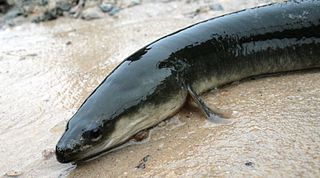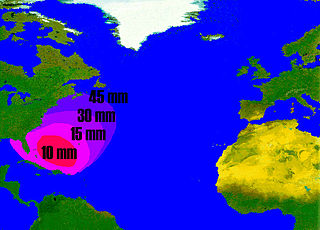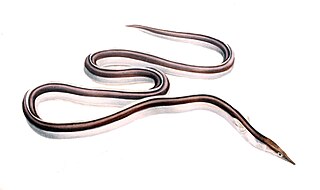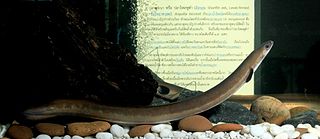
The American eel is a facultative catadromous fish found on the eastern coast of North America. Freshwater eels are fish belonging to the elopomorph superorder, a group of phylogenetically ancient teleosts. The American eel has a slender, supple, snake-like body that is covered with a mucus layer, which makes the eel appear to be naked and slimy despite the presence of minute scales. A long dorsal fin runs from the middle of the back and is continuous with a similar ventral fin. Pelvic fins are absent, and relatively small pectoral fins can be found near the midline, followed by the head and gill covers. Variations exist in coloration, from olive green, brown shading to greenish-yellow and light gray or white on the belly. Eels from clear water are often lighter than those from dark, tannic acid streams.

Eels are any of several long, thin, bony fishes of the order Anguilliformes. They have a catadromous life cycle, that is: at different stages of development migrating between inland waterways and the deep ocean. Because fishermen never caught anything they recognized as young eels, the life cycle of the eel was long a mystery. Of particular interest has been the search for the spawning grounds for the various species of eels, and identifying the population impacts of different stages of the life cycle.

The Anguillidae are a family of ray-finned fish that contains the freshwater eels. All the extant species and six subspecies in this family are in the genus Anguilla, and are elongated fish of snake-like bodies, with long dorsal, caudal and anal fins forming a continuous fringe. They are catadromous, spending their adult lives in freshwater, but migrating to the ocean to spawn.

The serpent eel or sand snake-eel is an eel found in the eastern Atlantic Ocean, western Mediterranean Sea, western Indian Ocean, western Pacific Ocean and the north-east and west coast of North Island in New Zealand. It is an elongated, slender fish with a length of up to 250 centimetres. It spends the day with its body immersed in the sediment, emerging into the open water at night.

The New Zealand longfin eel, also known as ōrea, is a species of freshwater eel that is endemic to New Zealand. It is the largest freshwater eel in New Zealand and the only endemic species – the other eels found in New Zealand are the native shortfin eel, also found in Australia, and the naturally introduced Australian longfin eel. Longfin eels are long-lived, migrating to the Pacific Ocean near Tonga to breed at the end of their lives. They are good climbers as juveniles and so are found in streams and lakes a long way inland. An important traditional food source for Māori, who name them ōrea, longfin eel numbers are declining and they are classified as endangered, but over one hundred tonnes are still commercially fished each year.

The speckled longfin eel, Australian long-finned eel or marbled eel is one of 15 species of eel in the family Anguillidae. It has a long snake-like cylindrical body with its dorsal, tail and anal fins joined to form one long fin. The dorsal fin also often extends farther than the anal fin. It usually has a brownish green or olive green back and sides with small darker spots or blotches all over its body. Its underside is paler. It has a small gill opening on each side of its wide head, with thick lips. It is Australia's largest freshwater eel, and the female usually grows much larger than the male. It is also known as the spotted eel.
Anguilla bengalensis labiata, the African mottled eel, is a subspecies of eel in the genus Anguilla of the family Anguillidae.

The Indonesian shortfin eel is a subspecies of eel in the genus Anguilla of the family Anguillidae. It is found throughout the tropical coastal regions of the Indian Ocean and Western Pacific Ocean.

Anguilla bicolor is a species of eel in the genus Anguilla of the family Anguillidae, consisting of two subspecies.

The mottled eel, also known as the African mottled eel, the Indian longfin eel, the Indian mottled eel, the long-finned eel or the river eel, is a demersal, catadromous eel in the family Anguillidae. It was described by John McClelland in 1844. It is a tropical, freshwater eel which is known from East Africa, Bangladesh, Andaman Islands, Mozambique, Malawi, Sri Lanka, Sumatra, and Indonesia and recently from Madagascar. The eels spend most of their lives in freshwater at a depth range of 3–10 metres, but migrate to the Indian Ocean to breed. Males can reach a maximum total length of 121 centimetres and a maximum weight of 7,000 grams. The eels feed primarily off of benthic crustaceans, mollusks, finfish and worms.

The Indian shortfin eel, Anguilla bicolor pacifica, is a species of eel in the genus Anguilla of the family Anguillidae. The Indian shortfin eel typically lives in fresh water or brackish water. The habitat use of the Indian shortfin eel is dependent on environmental factors.

Acanthopterygii is a superorder of bony fishes in the class Actinopterygii. Members of this superorder are sometimes called ray-finned fishes for the characteristic sharp, bony rays in their fins; however this name is often given to the class Actinopterygii as a whole.

The giant mottled eel, also known as the marbled eel, is a species of tropical anguillid eel that is found in the Indo-Pacific and adjacent freshwater habitats.

Eels are ray-finned fish belonging to the order Anguilliformes, which consists of eight suborders, 20 families, 164 genera, and about 1000 species. Eels undergo considerable development from the early larval stage to the eventual adult stage and are usually predators.
Blennophis anguillaris, the snaky klipfish, is a species of clinid found in the subtropical waters of the Atlantic Ocean around South Africa. It can be found in the subtidal zone and also is a denizen of tidepools. This species can reach a maximum length of 30 centimetres (12 in) TL.
The Polynesian longfinned eel, also known as the Pacific long-finned eel, is an eel in the family Anguillidae. It was described by Johann Jakob Kaup in 1856. It is a tropical eel found in freshwaters in the Pacific, including Sulawesi, Indonesia; the Society Islands, and Pitcairn. The eels spend most of their lives in freshwater, but migrate to the ocean to breed. Males can reach a maximum total length of 100 centimetres, while females can reach a maximum TL of 165 centimetres and a maximum weight of 9,000 grams.
The Pacific shortfinned eel, also known as the Pacific shortfinned freshwater eel, the short-finned eel, and the South Pacific eel, is an eel in the family Anguillidae. It was described by Albert Günther in 1871. It is a tropical, freshwater eel which is known from western New Guinea, Queensland, Australia, the Society Islands, and possibly South Africa. The eels spend most of their lives in freshwater, but migrate to the Pacific Ocean to breed. Males can reach a maximum total length of 110 centimetres, but more commonly reach a TL of around 60 cm. The Pacific shortfinned eel is most similar to Anguilla australis, and Anguilla bicolor, but can be distinguished by the number of vertebrae.
Cyvirus anguillidallo1, also known as Anguillid herpesvirus 1 (AngHV-1) is a species of virus in the genus Cyprinivirus, family Alloherpesviridae, and order Herpesvirales.











